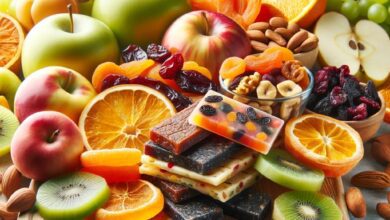40 Foods to Lower Cholesterol: A Healthy Guide

1. Introduction
Cholesterol: a word that often brings to mind medical concerns and dietary precautions. But what exactly is cholesterol, and why does it matter? More importantly, how can we take control of it through our diet? In this comprehensive guide, we will explore 40 Foods to Lower Cholesterol, a journey that takes us into the heart of heart health.
1.1. The importance of managing cholesterol levels for overall health
Cholesterol is not inherently bad. In fact, it’s essential for building cell membranes and hormones. The issue arises when the balance between Low-Density Lipoprotein (LDL) and High-Density Lipoprotein (HDL) gets disturbed. High levels of LDL, or “bad cholesterol,” can lead to heart disease and stroke. That’s where the right diet comes in.
1.2. Overview of the article’s scope and key takeaways
From understanding the basic concepts of cholesterol to diving deep into the cholesterol-lowering foods that should grace your plate, this article is a healthy guide for everyone. Whether you’ve been diagnosed with high cholesterol or simply want to adopt a heart-healthy diet, you’ll find practical tips, delicious food recommendations, and natural strategies to lower cholesterol effectively.
Prepare to embark on a flavorful journey, discovering the top 40 Foods to Lower Cholesterol and how to incorporate them into your daily meals. Get ready to take charge of your health, one bite at a time!
2. Understanding Cholesterol: The Basics
Understanding cholesterol is essential to navigate your way through a heart-healthy lifestyle. But what exactly is cholesterol, and why should you care about it? Let’s break down the basics.
2.1. What is cholesterol? Differentiating between HDL and LDL cholesterol.
Cholesterol is a fatty substance that’s found in your blood. It’s a crucial building block for producing hormones, Vitamin D, and other substances that help digest food. But, not all cholesterol is created equal:
- High-Density Lipoprotein (HDL cholesterol): Often referred to as the “good cholesterol,” HDL helps remove cholesterol from your arteries. Think of HDL as the garbage truck of your body, collecting waste and keeping your arteries clean and healthy.
- Low-Density Lipoprotein (LDL cholesterol): Known as the “bad cholesterol,” LDL deposits cholesterol into your arteries, which can lead to blockages and heart disease. Imagine LDL as clutter that can clog your arteries if left unchecked.
This distinction between HDL and LDL cholesterol is crucial for understanding how to manage your cholesterol levels effectively.
2.2. Causes and risks associated with high cholesterol levels.
High cholesterol levels are often linked to unhealthy lifestyle choices like a diet high in saturated fat and a lack of physical activity. Other factors can include genetics, age, and underlying health conditions.
Risks associated with high cholesterol include:
- Heart Attack
- Stroke
- Narrowing of Arteries (atherosclerosis)
- Other cardiovascular diseases
To put it simply, high cholesterol levels can lead to severe health problems and must be managed properly to reduce the risk of heart disease.
2.3. Cholesterol levels: Normal vs. elevated ranges.
Cholesterol levels can be measured through a simple blood test, often referred to as a lipid panel. Here’s a general guideline to understand your cholesterol levels:
- Total Cholesterol: Under 200 mg/dL is considered desirable.
- LDL Cholesterol: Less than 100 mg/dL is optimal.
- HDL Cholesterol: 60 mg/dL or higher is protective against heart disease.
Keep in mind that these are general ranges, and individual recommendations may vary. Regular check-ups with healthcare professionals and focusing on a low cholesterol diet can go a long way in maintaining healthy cholesterol levels.
In Conclusion, understanding cholesterol is the foundation of a heart-healthy life. Differentiating between good (HDL) and bad (LDL) cholesterol, recognizing the risks associated with high cholesterol levels, and knowing the difference between normal and elevated ranges are essential first steps.
Embrace a heart-healthy diet and lifestyle to keep cholesterol in check. It’s more than just numbers; it’s about your overall well-being.
3. Dietary Solutions: Foods and Their Impact on Cholesterol
Cholesterol management is a vital part of maintaining good heart health, and your diet plays an instrumental role in this process. By understanding the relationship between food and cholesterol, you can craft a diet that keeps your heart happy. Let’s explore this aspect in detail.
3.1. 40 Foods to Lower Cholesterol – A comprehensive list.
Cholesterol management is essential for maintaining heart health, and one of the best ways to manage cholesterol levels is through diet. Here, we provide a comprehensive list of 40 foods known to lower cholesterol:
- Oats: A great source of soluble fiber, oats help reduce LDL cholesterol levels.
- Barley: Similar to oats, barley contains soluble fiber that can lower cholesterol.
- Beans: High in fiber, beans are excellent for heart health and cholesterol reduction.
- Lentils: Lentils contain nutrients that can lower cholesterol levels.
- Almonds: Rich in unsaturated fats, almonds can help reduce bad cholesterol.
- Walnuts: Containing omega-3 fatty acids, walnuts can improve cholesterol levels.
- Fatty Fish: Salmon, mackerel, and sardines contain omega-3s that reduce LDL cholesterol.
- Olive Oil: A healthy fat that can lower bad cholesterol levels.
- Avocados: High in monounsaturated fats, avocados are beneficial for heart health.
- Whole Grains: Foods like whole wheat and brown rice can lower cholesterol.
- Flax Seeds: Rich in alpha-linolenic acid, flax seeds can lower LDL cholesterol.
- Soy Products: Including tofu and soy milk, these can be part of a cholesterol-lowering diet.
- Blueberries: Contain antioxidants that may lower LDL cholesterol.
- Spinach: Contains lutein, which can help reduce cholesterol.
- Garlic: Known to reduce cholesterol levels and improve heart health.
- Citrus Fruits: Rich in pectin, they can help lower LDL cholesterol.
- Apples: Contain both soluble fiber and pectin to reduce bad cholesterol.
- Grapes: High in antioxidants that may lower LDL cholesterol.
- Tomatoes: Contain lycopene, which can lower LDL cholesterol.
- Carrots: Rich in soluble fiber, carrots can reduce cholesterol levels.
- Sweet Potatoes: Another fiber-rich food beneficial for cholesterol reduction.
- Red Wine: In moderation, can increase HDL and lower LDL cholesterol.
- Green Tea: Known for its cholesterol-lowering properties.
- Dark Chocolate: With at least 70% cocoa, can improve heart health.
- Eggplant: Contains fiber and antioxidants beneficial for lowering cholesterol.
- Okra: High in soluble fiber, okra can reduce LDL cholesterol.
- Chia Seeds: Containing omega-3s, they can help reduce bad cholesterol.
- Kale: A nutrient-dense vegetable that can lower cholesterol levels.
- Pomegranates: Rich in antioxidants, may reduce LDL cholesterol.
- Mushrooms: Various species have been shown to lower cholesterol.
- Brussels Sprouts: High in fiber, can assist in cholesterol reduction.
- Broccoli: Contains nutrients that may lower bad cholesterol.
- Turmeric: Its active compound, curcumin, can reduce LDL cholesterol.
- Artichokes: Known to improve overall cholesterol profile.
- Hazelnuts: Like other nuts, they contain fats beneficial for heart health.
- Pistachios: May reduce cholesterol levels when included in a balanced diet.
- Cauliflower: High in fiber, and can assist in cholesterol reduction.
- Strawberries: Contain antioxidants that may lower LDL cholesterol.
- Cherries: Rich in antioxidants, and may reduce bad cholesterol.
- Pears: High in fiber, pears can be part of a cholesterol-lowering diet.
These 40 foods provide a diverse and flavorful way to approach cholesterol reduction. Whether incorporated into meals or enjoyed on their own, these ingredients can make a significant positive impact on your heart’s health. Always consult with a healthcare provider to tailor these suggestions to your unique dietary needs and health goals.
3.2. Cholesterol-reducing foods vs. foods that elevate cholesterol.
Understanding which foods lower cholesterol and which ones raise it is crucial for heart health. Foods high in saturated fat, like red meat and full-fat dairy products, can increase cholesterol levels.
On the other hand, foods rich in omega-3 fatty acids and soluble fiber can reduce cholesterol.
Cholesterol-reducing foods:
- Fruits and vegetables
- Whole grains
- Nuts and seeds
- Lean proteins
Foods that elevate cholesterol:
- Processed meats
- Fried foods
- Sugary treats
- Full-fat dairy products
The goal is to integrate more cholesterol-lowering foods into your daily diet while reducing the foods that can elevate cholesterol levels.
3.3. Heart-healthy foods and their role in a balanced diet.
Eating heart-healthy foods is about more than just lowering cholesterol; it’s about nurturing your entire cardiovascular system. These include:
- Fruits and vegetables: Rich in vitamins, minerals, and antioxidants.
- Whole grains: Provide fiber to help lower cholesterol naturally.
- Lean proteins: Including fish and poultry, helps maintain healthy blood pressure.
In addition to foods for heart health, a balanced lifestyle that includes regular exercise, stress management, and avoiding tobacco and excessive alcohol can further protect your heart.
Remember, crafting a low cholesterol diet doesn’t have to be restrictive or boring. Explore the variety of foods to lower cholesterol, enjoy creative meal planning, and embrace the journey to heart health.
4. Natural Ways to Maintain and Improve Heart Health
When it comes to heart health, medication isn’t always the first line of defense. Natural ways to lower cholesterol are not only effective but also enhance overall well-being. Below are some crucial aspects to consider:
4.1. Natural Ways to Lower Cholesterol Through Diet and Lifestyle Changes
The food you eat plays a significant role in your cholesterol levels. But did you know there are also other natural ways to lower cholesterol?
Cholesterol-lowering foods like oatmeal, almonds, and fatty fish are potent remedies. So are lifestyle changes like quitting smoking or reducing alcohol consumption. Here’s how you can leverage these:
- Heart-healthy foods: Focus on fruits, vegetables, whole grains, and lean meats.
- Lower cholesterol naturally: Avoid trans fats and choose healthier cooking oils.
- Low cholesterol diet: Balance your diet with a variety of nutrient-rich foods.
These changes not only lower LDL but also increase HDL, the good cholesterol.
4.2. Role of Exercise, Weight Management, and Stress Reduction
Physical activity is a keystone for maintaining optimal cholesterol levels. Here’s why:
- Exercise: Helps to lower LDL (bad cholesterol) and raise HDL (good cholesterol).
- Weight management: Shedding even a few pounds can make a significant difference.
- Stress reduction: Meditation, hobbies, and relaxation techniques can have a positive impact.
Remember, it’s not about drastic changes but consistent efforts that matter.
4.3. Daily Diet for Heart Health: Crafting a Balanced Meal Plan
What does a daily diet for heart health look like? It’s all about choosing the right balance.
- Fatty fish: Rich in omega-3 fatty acids, it helps to reduce heart disease risks.
- Olive oil: A source of polyunsaturated fat, it helps in reducing LDL levels.
- Soluble fiber: Foods like beans and lentils help in absorbing cholesterol.
Crafting a meal plan that incorporates these elements can provide long-term benefits. From breakfast to dinner, make choices that align with a heart-healthy philosophy.
In conclusion, Improving heart health naturally is within your reach. By focusing on a low cholesterol diet, integrating exercise, and managing stress, you can make strides toward a healthier life.
What are you waiting for? Start your journey towards a heart-healthy lifestyle today!
5. Dive Deeper: Exploring Specific Food Types and Their Benefits
In this section, we’ll delve into specific foods and nutrients that play a vital role in maintaining heart health. With the focus on 40 Foods to Lower Cholesterol, understanding the science behind these foods will help you make informed dietary choices.
5.1. Fatty fish, omega-3 fatty acids, and heart health
Fatty fish like salmon, mackerel, and sardines are not only delicious but also packed with omega-3 fatty acids. These fatty acids are renowned for their heart-healthy benefits, including:
- Lowering LDL cholesterol: Omega-3 helps reduce bad cholesterol and increase good HDL cholesterol.
- Reducing the risk of heart disease: Regular consumption can decrease inflammation and blood pressure.
- Supporting overall heart health: These nutrients enhance blood vessel function and decrease triglycerides.
Incorporating fatty fish into your weekly diet can be a tasty way to boost heart health. From grilled salmon to smoked mackerel, there are endless delicious recipes to explore.
5.2. Olive oil, polyunsaturated fats, and their cholesterol-lowering properties
Olive oil, rich in polyunsaturated fats, has been a staple in the Mediterranean diet and is recognized for its cholesterol-lowering properties:
- Reduces bad LDL cholesterol: Olive oil helps clear the harmful cholesterol that can clog arteries.
- Boosts HDL cholesterol: It promotes good cholesterol, improving heart function.
- Enhances overall heart health: By reducing inflammation and improving blood vessel function.
Switching to olive oil for cooking and salad dressing can be a simple yet effective step to integrate foods to lower cholesterol into your daily meals.
5.3. Soluble fiber: Why it matters and where to find it
Soluble fiber plays a crucial role in reducing cholesterol. Here’s how:
- Binding cholesterol: It binds with cholesterol particles in your digestive system and helps remove them from the body.
- Regulating cholesterol levels: Consuming foods rich in soluble fiber can significantly lower cholesterol naturally.
- Good sources of soluble fiber: Oats, beans, lentils, and fruits are excellent options.
Adding more of these cholesterol-reducing foods to your diet can lead to a heart-healthy lifestyle.
Conclusion
These specific food types represent just a portion of the 40 Foods to Lower Cholesterol: A Healthy Guide. By understanding the science behind their benefits, you can make more informed and healthful dietary choices.
Would you like to try these foods? Start today and feel the difference in your heart health!
6. Practical Tips and Recommendations
6.1. How to Lower Cholesterol Naturally: Tips and Strategies
Understanding how to lower cholesterol naturally is essential for long-term health and well-being. Here’s how you can do it:
- Eat Foods for Heart Health: Incorporate cholesterol-reducing foods like oatmeal, nuts, and fatty fish rich in omega-3 fatty acids.
- Avoid Saturated Fat: Minimize intake of high saturated fat items like red meat.
- Exercise Regularly: Regular exercise helps in managing cholesterol levels and reduces the risk of heart disease.
Did you know that something as simple as laughing more can contribute to heart health? Laughter triggers the release of endorphins, promoting good blood flow, and can even reduce inflammation in your arteries!
6.2. Lower Cholesterol Foods: Incorporating Them into Daily Meals
The art of lower cholesterol foods is not just about what you eat, but how you eat it. Here’s a guide:
- Use Olive Oil: Substitute butter with olive oil, polyunsaturated fat that helps lower LDL cholesterol.
- Add Soluble Fiber: Include foods high in soluble fiber, like beans and whole grains.
- Choose Lean Proteins: Opt for lean meats and plant proteins to maintain a low cholesterol diet.
A family favorite in my household is a grilled vegetable salad drizzled with olive oil. It’s tasty, filling, and heart-healthy!
6.3. Avoiding High-Risk Foods and Habits that Elevate Cholesterol
Steering clear of the dangers of high cholesterol requires conscious choices. Here’s what to avoid:
- Trans Fats: Often found in processed foods, trans fats can elevate bad cholesterol.
- Excessive Alcohol: Moderation is key to preventing elevating LDL levels.
- Smoking: Smoking can lower HDL cholesterol, the “good” cholesterol, putting your heart at risk.
Have you ever thought about joining a community health group? Engaging with others on the same health journey can offer encouragement, accountability, and shared experiences to make these changes more enjoyable.
Conclusion
By embracing these practical tips and recommendations, you’re not just working towards lower cholesterol naturally; you’re investing in a future filled with wellness and vitality.
From foods to lower cholesterol to mindful daily habits, the journey toward a heart-healthy diet is one filled with exploration, enjoyment, and, most importantly, empowerment. So why not take the first step today? Your heart will thank you!
7. Conclusion
7.1. Emphasizing the importance of a low cholesterol diet for heart health
Maintaining a low cholesterol diet isn’t merely about avoiding certain foods; it’s about making choices that lead to a heart-healthy lifestyle. With the rise in heart diseases, it’s more crucial than ever to understand the connection between cholesterol levels and overall health.
You see, cholesterol isn’t necessarily a villain; it’s how you manage it that counts. By incorporating cholesterol-lowering foods and foods for heart health, you can effectively reduce the risk of heart disease.
Did you know that simple choices like opting for fatty fish over fried meats or using olive oil instead of butter can make a big difference? It’s the small, mindful decisions that add up, shaping your health for the future.
7.2. Encouraging regular health checks and blood tests
Regular health checks aren’t just for those with health issues; they are for everyone. They allow early detection of potential problems such as high cholesterol, blood pressure, or heart conditions. So why wait for a health crisis to strike? Regular blood tests and screenings can help in identifying the LDL levels and HDL cholesterol in your body. By understanding these numbers, you can make informed decisions about your diet and lifestyle.
7.3. Parting advice for maintaining a heart-healthy lifestyle
To conclude, embarking on a journey towards a heart-healthy lifestyle doesn’t have to be complex or overwhelming. Begin with small steps like adding more cholesterol-reducing foods to your meals, or taking short walks daily. Embrace natural ways to lower cholesterol through diet and exercise, and don’t hesitate to seek professional guidance if needed.
Remember, your heart is at the core of your well-being. Treat it with care and feed it with love. Engage with heart-smart choices today and enjoy the benefits for a lifetime.
So, what’s your next step toward a heart-healthy life? Share your thoughts, and let’s walk this path together.
8. Frequently Asked Questions (FAQs)
Q1. What are the top 5 foods to lower cholesterol naturally?
A: The top 5 foods to lower cholesterol naturally include oats, fatty fish like salmon and mackerel, almonds and other nuts, avocados, and olive oil. These foods are rich in soluble fiber, omega-3 fatty acids, and healthy fats that can help reduce LDL cholesterol levels and improve HDL cholesterol. Incorporating these into a balanced diet can promote a heart-healthy lifestyle.
Q2. How can I lower my cholesterol levels without medication?
A: You can lower your cholesterol levels without medication by making lifestyle changes. Emphasize a low cholesterol diet, rich in fruits, vegetables, whole grains, and cholesterol-lowering foods. Avoid saturated fats, and choose lean proteins such as chicken, turkey, or fish. Regular exercise, quitting smoking, and limiting alcohol can also have significant impacts. Always consult with a healthcare provider to understand the best approach for your unique situation.
Q3. Are eggs bad for cholesterol?
A: Eggs have been a controversial subject when it comes to cholesterol. While they are high in dietary cholesterol, current research suggests that they don’t have a significant effect on blood cholesterol levels for most people. Including eggs as part of a diet that’s low in saturated fats and high in cholesterol-reducing foods may still support heart health. However, those with certain health conditions may need to limit or avoid eggs, so it’s best to consult with a healthcare provider.
Q4. What are the risks of having high cholesterol?
A: High cholesterol can lead to the buildup of plaque in the arteries, leading to a condition known as atherosclerosis. This can cause narrowing or blocking of the arteries, increasing the risk of heart disease, heart attack, and stroke. High cholesterol often has no symptoms, so regular screenings are vital to assess your risk and take appropriate measures, such as a low cholesterol diet or medication if needed.
Q5. How often should I have my cholesterol levels checked?
A: For adults, it’s generally recommended to have cholesterol levels checked every 4 to 6 years. However, frequency may vary based on age, family history, and other risk factors such as obesity or diabetes. If you have high cholesterol or other heart risk factors, more frequent testing may be required. Collaborating with your healthcare provider to understand your specific needs and tailor a plan that includes a heart-healthy diet and regular monitoring can be a proactive approach to maintaining health.
These FAQs offer valuable insights into common queries related to cholesterol and how to manage it through diet and lifestyle. They provide a comprehensive and easy-to-understand overview for readers seeking practical, actionable advice.





